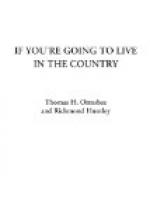So “if only” has become an actuality. The old house is now comfortably settled on its new site and like most transplanted things will thrive better if some faint flavor of its old surroundings is present, such as an apple orchard or one or two fine old trees that look as if they and the house had grown old together.
THE SMOKE GOES UP THE CHIMNEY
[Illustration]
CHAPTER VIII
THE SMOKE GOES UP THE CHIMNEY
“Remember that the new chimneys are not to smoke,” wrote General Washington from New York in 1776 to his kinsman and overseer, Lund Washington, regarding the remodeling of Mount Vernon. That admonition is just as necessary today as then. A chimney is still an essential part of a house. Also, despite the newest and most effective heating systems, family life, in the country at least, still centers around the hearth. Old, new, or merely middle-aged, no country home is considered properly equipped without at least one fireplace.
There is no use in pretending that they are needed for heat, but the leaping flames and brisk crackling of burning twigs are a cheery sight and sound. “Harriet will have her fireplace fire even though she has to open all the doors and windows,” chuckled one householder. This ceases to be a pleasantry if doors and windows have to be thrown wide to let out smoke instead of excess heat. Then this center of family cheer becomes as exasperating as any other inanimate thing that doesn’t work.
If, by purchase of an existing structure, a householder has become heir to such a problem, simple things, like fireplace hoods, capping the chimney, or increasing its height, can be tried. If these fail, architectural counsel is the next step. Such trouble is more frequent in houses dating after the stove era than before. The old masons built fireplaces for practical use rather than for occasional indulgence. They had never heard of aerodynamics but they knew how to construct fireplaces that would give out real heat as well as chimneys that carried the smoke where it belonged, up and out.
Of course some unwise features are to be found in the old work but, for the most part, design and proportions cannot be improved. The angles of sides and back, size of opening and throat, location of smoke shelf, size and proportions of smoke chamber, all were determined through years of rule of thumb experiment where only the best results survived. Therefore, the owner of an antique country home with chimney and fireplaces intact should think twice before he gives orders to demolish them. Similarly, he who is building a new house can well plan to reproduce the old fireplaces in size and shape.
Building proper chimneys and hearths was slowly evolved through the centuries. In the late 18th century, an American codified this masonic lore and established the scientific basis for a proper fireplace so cogently that even today his principles form the backbone of fireplace building. He was born Benjamin Thompson, March 26, 1753, at Woburn, Massachusetts, but is better known as Count von Rumford of the Holy Roman Empire.




